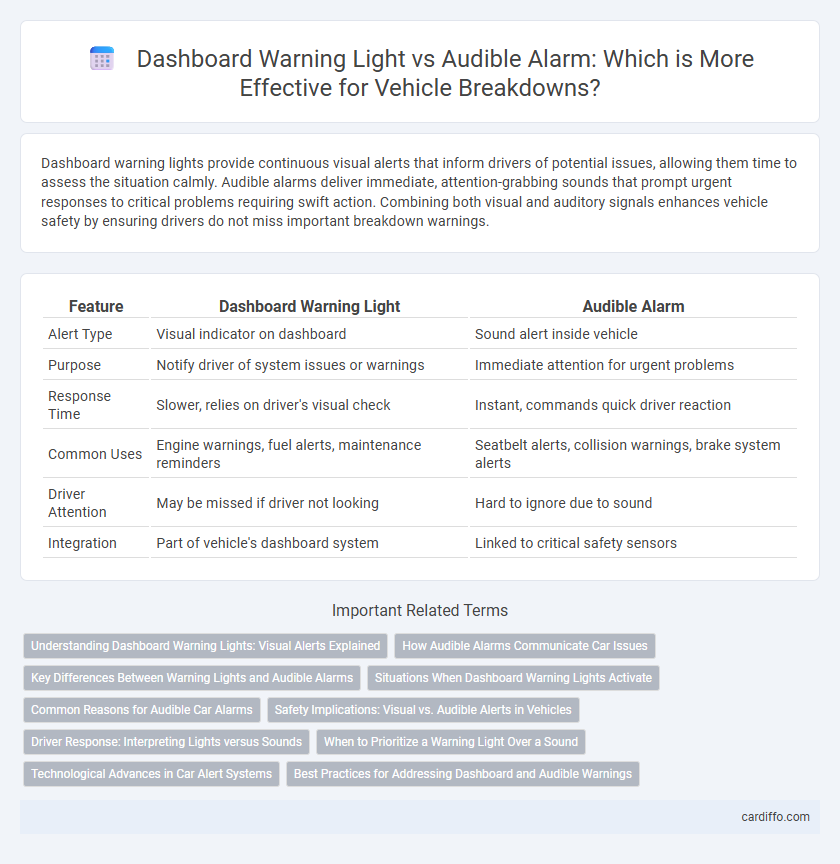Dashboard warning lights provide continuous visual alerts that inform drivers of potential issues, allowing them time to assess the situation calmly. Audible alarms deliver immediate, attention-grabbing sounds that prompt urgent responses to critical problems requiring swift action. Combining both visual and auditory signals enhances vehicle safety by ensuring drivers do not miss important breakdown warnings.
Table of Comparison
| Feature | Dashboard Warning Light | Audible Alarm |
|---|---|---|
| Alert Type | Visual indicator on dashboard | Sound alert inside vehicle |
| Purpose | Notify driver of system issues or warnings | Immediate attention for urgent problems |
| Response Time | Slower, relies on driver's visual check | Instant, commands quick driver reaction |
| Common Uses | Engine warnings, fuel alerts, maintenance reminders | Seatbelt alerts, collision warnings, brake system alerts |
| Driver Attention | May be missed if driver not looking | Hard to ignore due to sound |
| Integration | Part of vehicle's dashboard system | Linked to critical safety sensors |
Understanding Dashboard Warning Lights: Visual Alerts Explained
Dashboard warning lights serve as visual alerts designed to quickly inform drivers of vehicle issues requiring attention. These lights use standardized colors and symbols to convey specific problems, such as engine malfunctions, low oil pressure, or brake system warnings. Understanding the meaning behind each dashboard warning light is critical for prompt and accurate vehicle maintenance decisions.
How Audible Alarms Communicate Car Issues
Audible alarms in vehicles provide immediate, attention-grabbing alerts that signal critical car malfunctions, surpassing dashboard warning lights in urgency. These sounds can vary from beeps to continuous tones, each pattern indicating specific issues such as engine overheating, brake failure, or low oil pressure. By engaging the driver's auditory senses, audible alarms ensure swift response to potential breakdowns, enhancing safety and preventing severe damage.
Key Differences Between Warning Lights and Audible Alarms
Warning lights provide visual cues on a vehicle's dashboard indicating specific system malfunctions or maintenance needs, allowing drivers to quickly identify issues such as engine faults or low oil pressure. Audible alarms emit sounds to capture immediate attention, often signaling urgent problems like overheating or brake failure that require prompt action. The key differences lie in sensory modality and urgency, with warning lights offering continuous visual alerts and audible alarms delivering immediate, attention-grabbing warnings.
Situations When Dashboard Warning Lights Activate
Dashboard warning lights activate when there are issues detected by the vehicle's onboard diagnostics, such as low oil pressure, engine overheating, or brake system malfunctions. These lights serve as immediate visual alerts to prompt drivers to check the specific system or seek maintenance. Audible alarms typically accompany only critical warnings like severe engine failure or airbag deployment to ensure driver attention during high-risk situations.
Common Reasons for Audible Car Alarms
Audible car alarms often trigger due to common issues such as faulty sensors, a low battery, or a malfunctioning door switch. These alarms serve as an immediate alert to potential breakdowns or security breaches, demanding prompt attention. Dashboard warning lights may indicate these problems as well but lack the urgent auditory signal crucial for swift response.
Safety Implications: Visual vs. Audible Alerts in Vehicles
Dashboard warning lights provide constant visual cues about vehicle issues, allowing drivers to identify problems without distraction, while audible alarms deliver immediate attention by signaling urgent malfunctions that require prompt action. Visual alerts may be overlooked if the driver is not looking directly at the dashboard, increasing the risk of delayed response, whereas audible alarms penetrate environmental noise, enhancing safety in critical breakdown scenarios. Combining both alert types significantly improves hazard awareness, ensuring drivers receive timely and effective warnings to prevent accidents or severe mechanical failure.
Driver Response: Interpreting Lights versus Sounds
Dashboard warning lights provide drivers with specific visual cues about vehicle issues, enabling quick identification of problems like low oil pressure or engine overheating. Audible alarms demand immediate attention through sound, often indicating urgent or critical malfunctions that require instant action to prevent breakdown. Drivers responding to visual signals can assess severity calmly, but auditory warnings trigger faster reflexes, crucial for safety during vehicle malfunction.
When to Prioritize a Warning Light Over a Sound
Prioritize a dashboard warning light over an audible alarm when monitoring non-critical issues that require attention without causing immediate panic, such as low fuel or minor maintenance reminders. Warning lights provide continuous visual alerts that allow drivers to assess conditions calmly and take appropriate action at their convenience. Audible alarms should be reserved for urgent situations requiring immediate response, while warning lights support ongoing vehicle health awareness.
Technological Advances in Car Alert Systems
Technological advances in car alert systems have enabled dashboard warning lights and audible alarms to work in tandem, enhancing driver awareness and safety. Modern vehicles integrate sensors and AI algorithms that analyze real-time data to trigger specific alerts tailored to various breakdown scenarios. These innovations improve diagnostic accuracy and allow drivers to respond promptly, minimizing vehicle damage and potential accidents.
Best Practices for Addressing Dashboard and Audible Warnings
Dashboard warning lights provide visual alerts of vehicle issues, while audible alarms deliver immediate sound notifications to capture driver attention. Best practices for addressing these alerts include promptly identifying the specific warning code through onboard diagnostics and consulting the vehicle's manual to determine severity. Implementing routine maintenance and ensuring both visual and audible systems are fully functional optimize response times and enhance overall vehicle safety.
Dashboard warning light vs audible alarm Infographic

 cardiffo.com
cardiffo.com